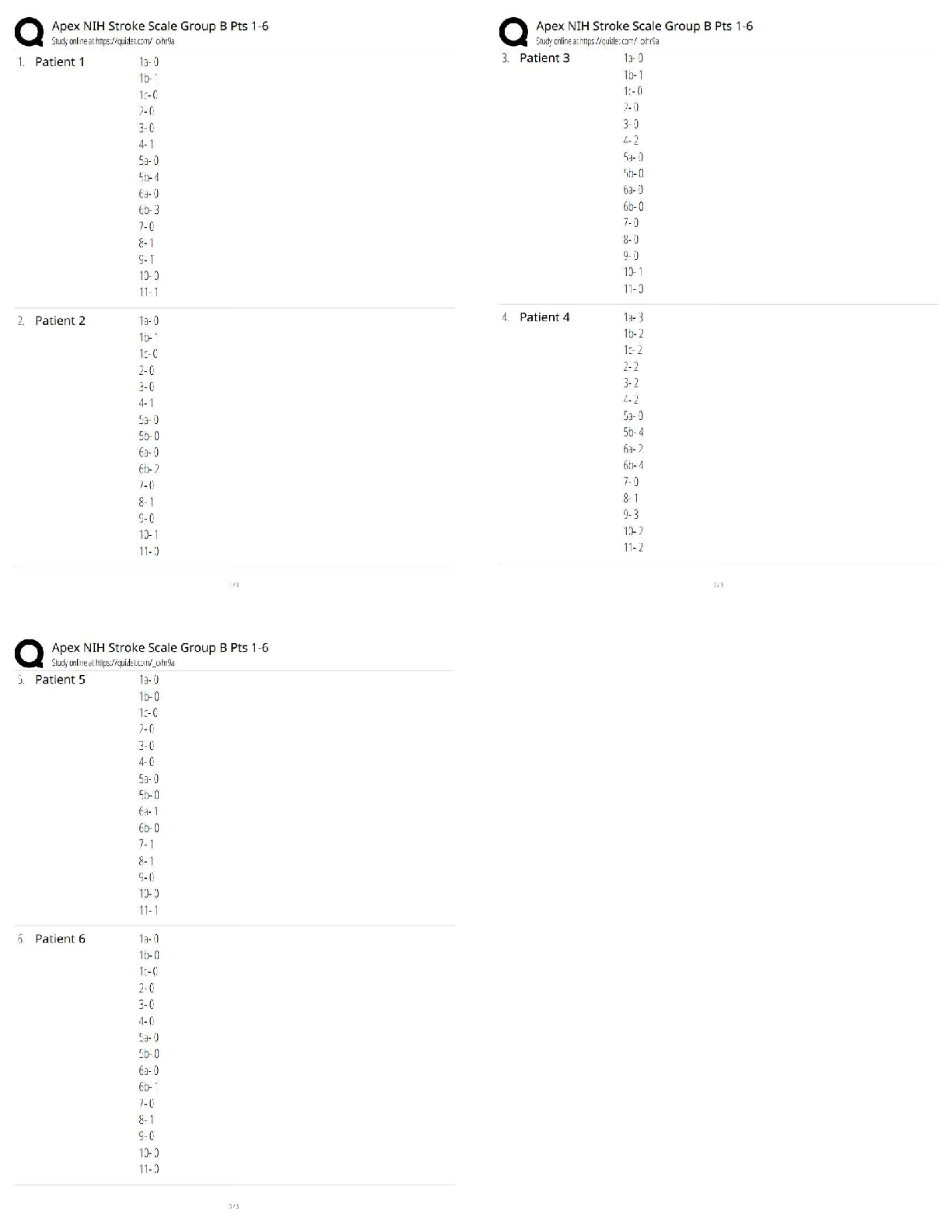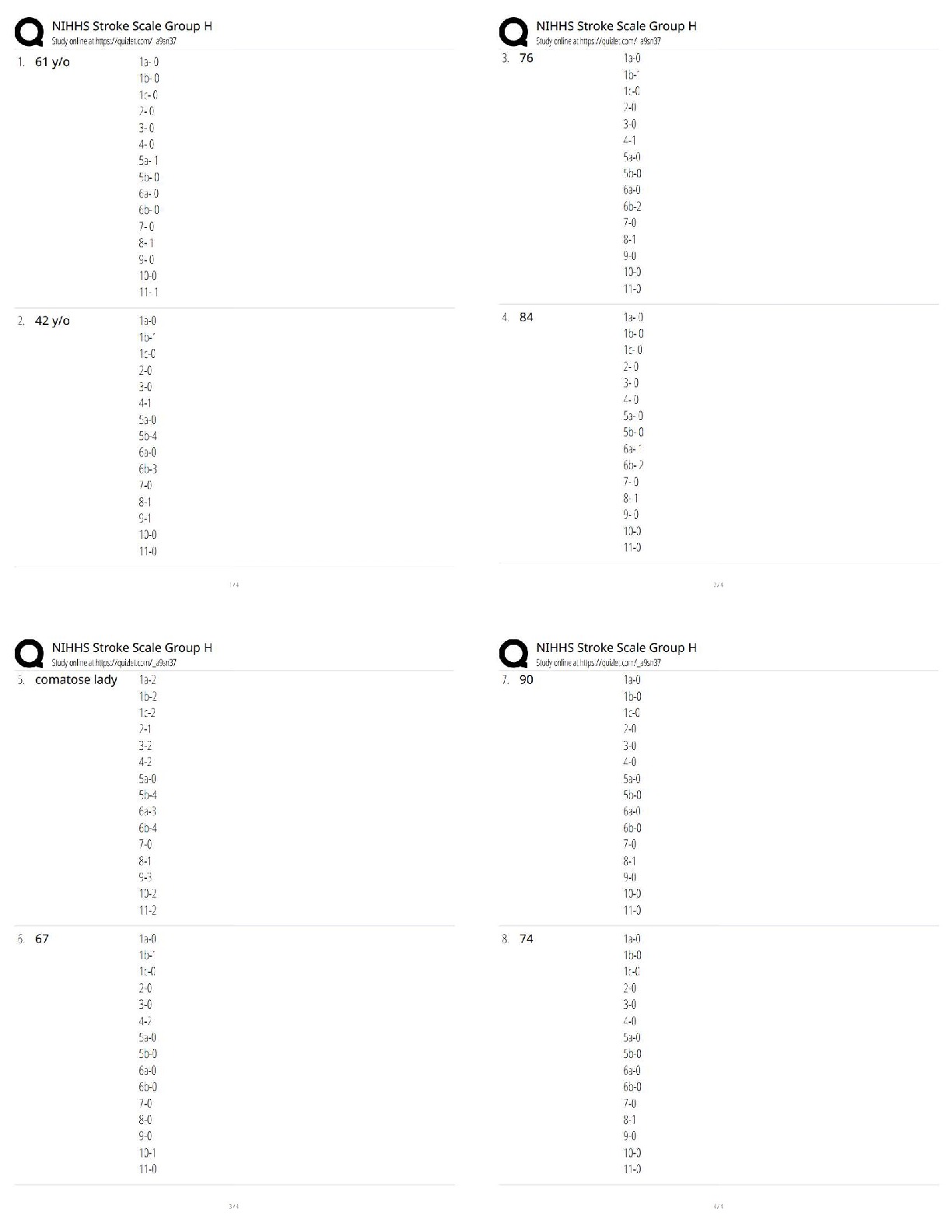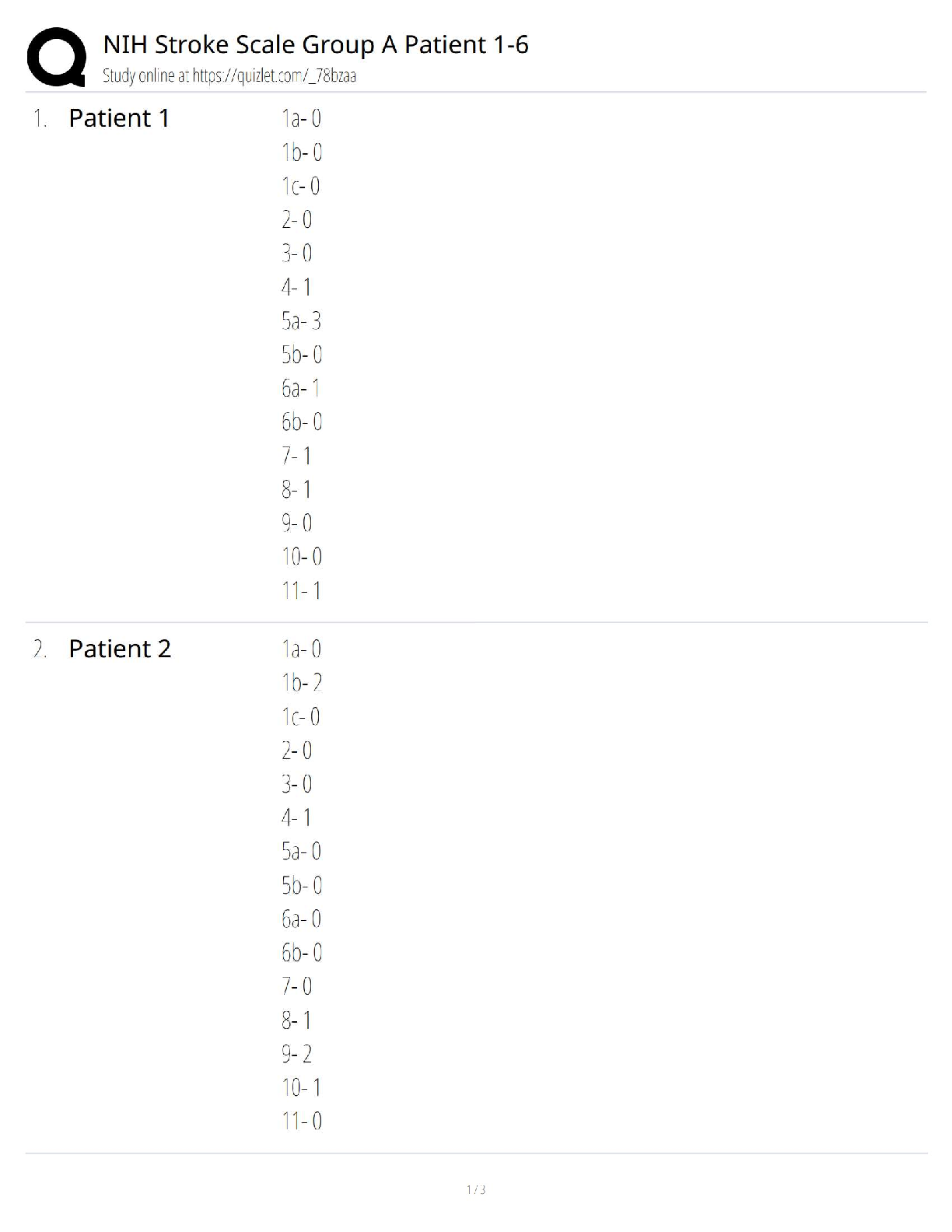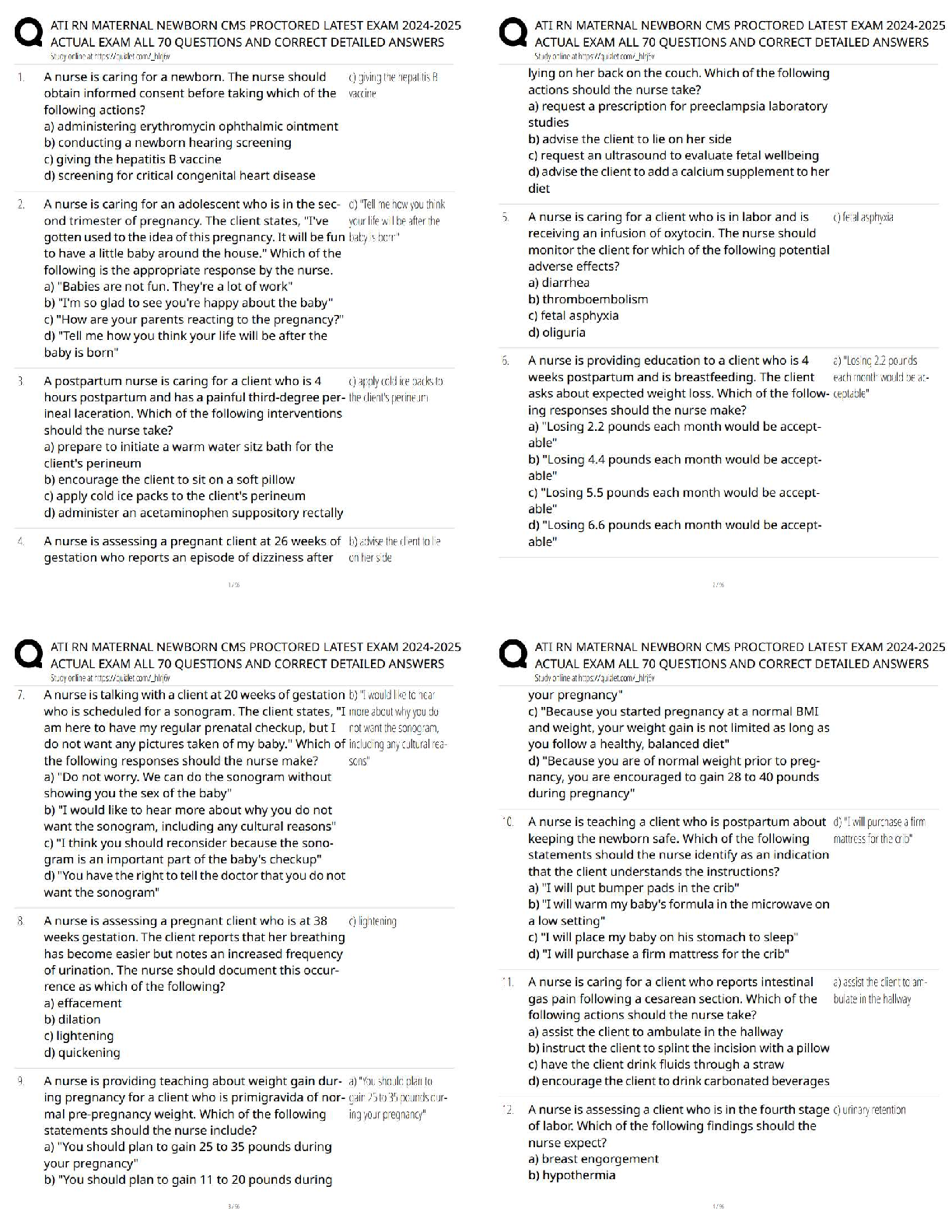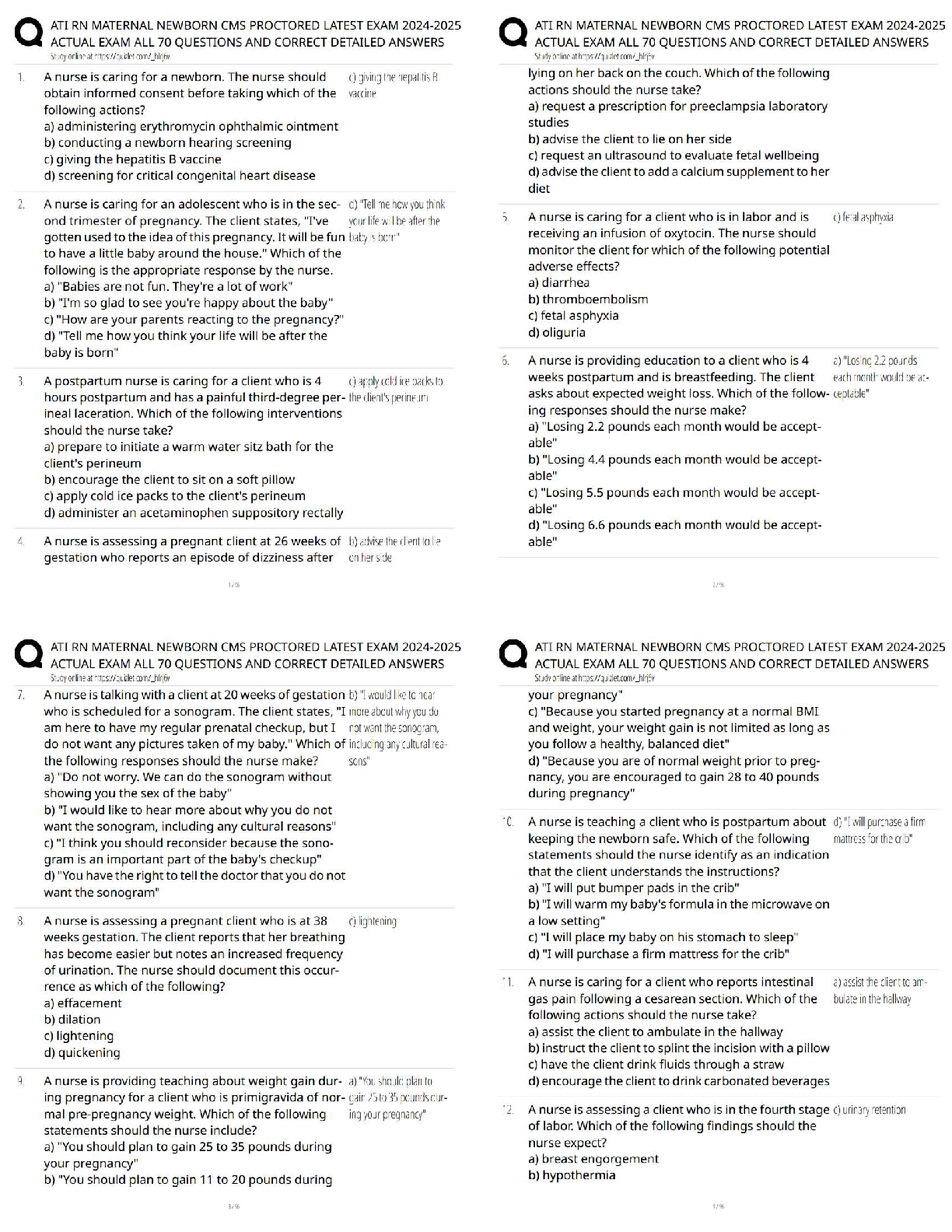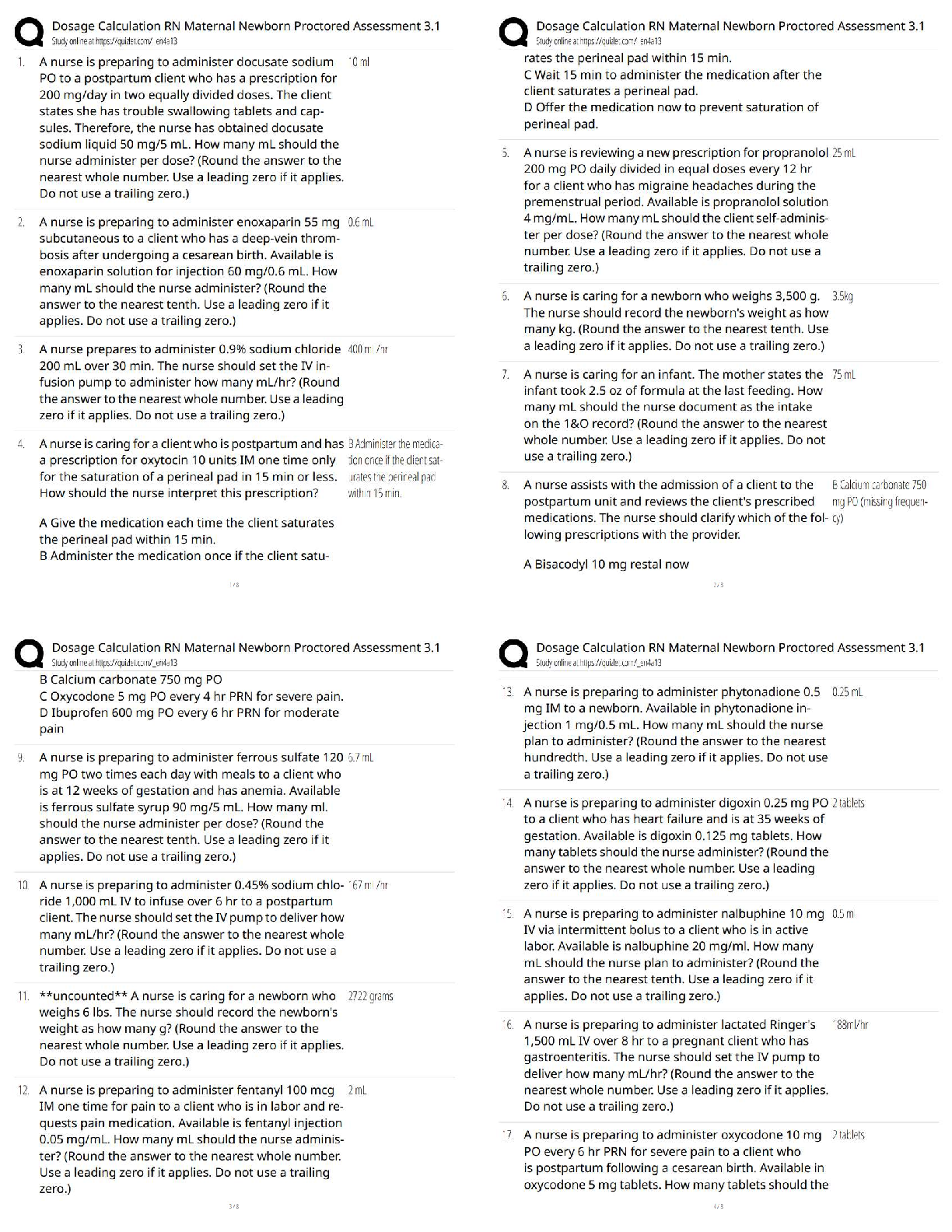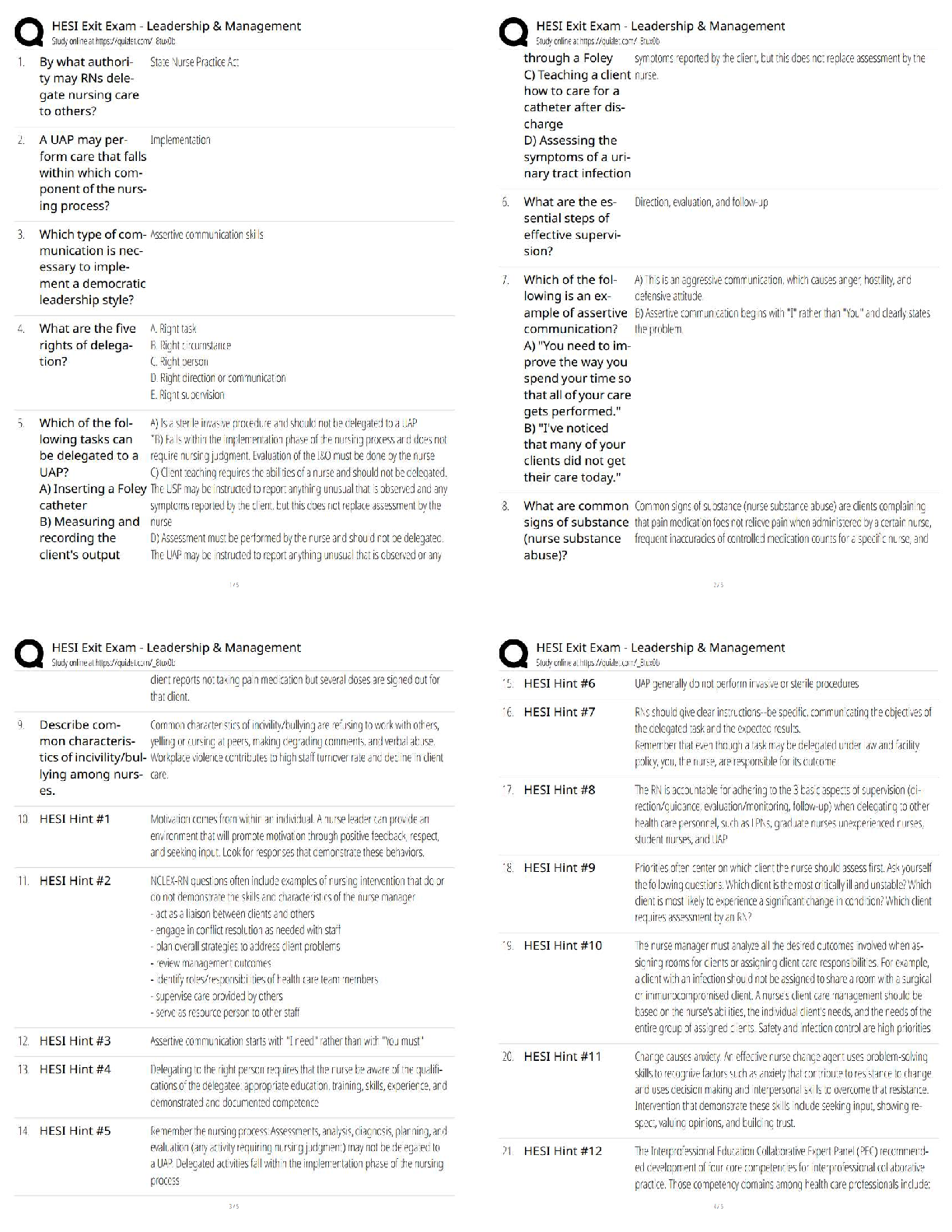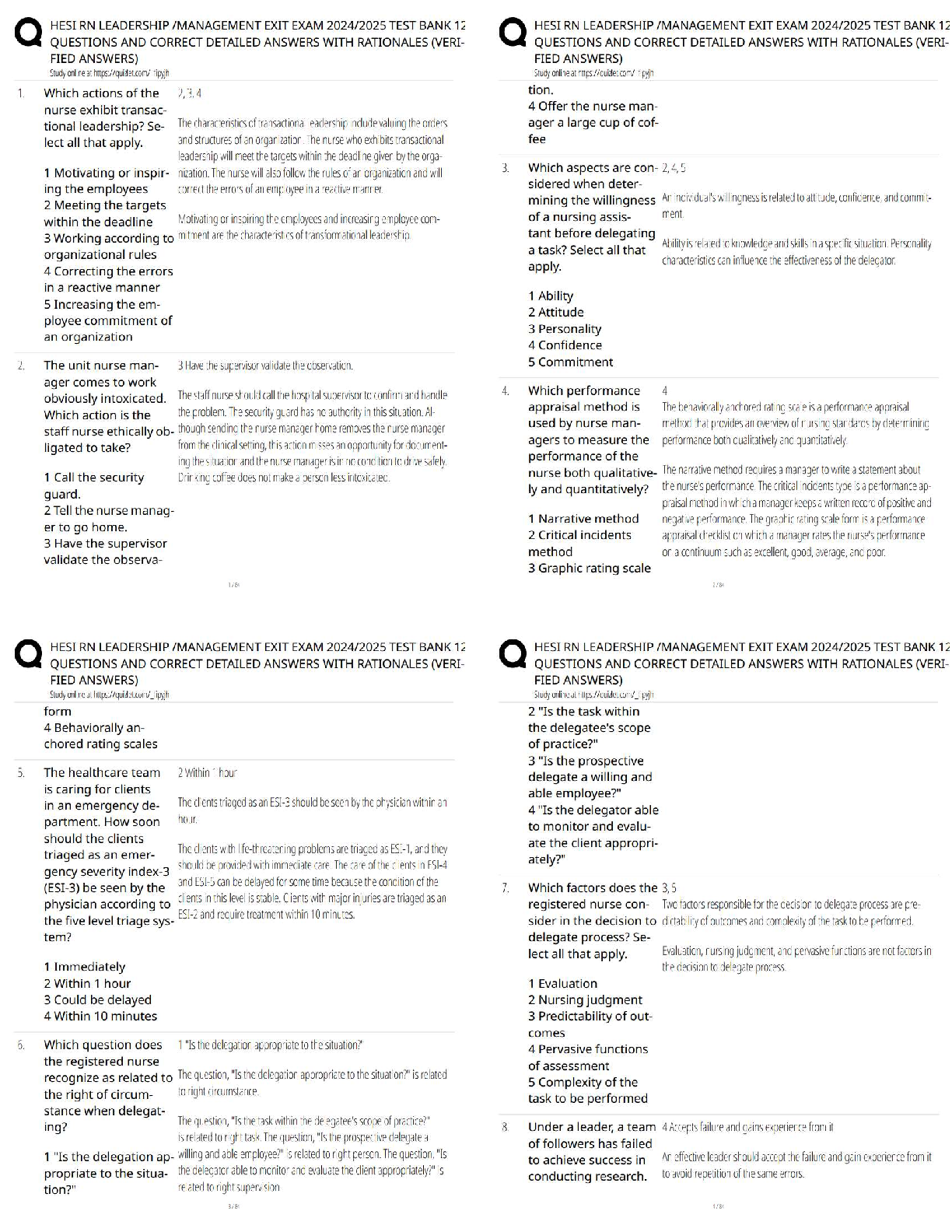*NURSING > QUESTIONS & ANSWERS > NRNP 6566 Week 9 Knowledge Check (100% Correct) Verified Answers (All)
NRNP 6566 Week 9 Knowledge Check (100% Correct) Verified Answers
Document Content and Description Below
A 32 year old preschool teacher complains of difficulty swallowing, sore throat, and chills. She is febrile with a temperature of 101.6 along with white patches on her tonsils. Her rapid strep test is ... positive. Her past medical history is positive for an anaphylactic reaction to cefaclor two years ago. What antibiotic could be safely utilized in this patient? Correct Answer: Streptococcus is usually treated with amoxicillin. Her type 1 anaphylactic re- action to a cephalosporin means you should not use a cephalosporin or peni- cillin. Acceptable alternatives would be macrolide such as azithromycin or clindamycin. A 20-year old woman was seen by her primary care provider last week and diagnosed with a lower track UTI. Her complaints at that time included burning on urination, frequent urination of a small amount, and superpubic pain. She was prescribed a 3 day course of Bactrim which she completed. She is admitted to the step down unit today with complaints of fever (102.6 and above) for the past 24 hours and CVA tenderness. She appears very ill and is somewhat confused today. Her BP is 100/62. Her family indicates that she has been vomiting for the last 24 hours and been unable to keep food or fluids down. What would your initial plan for this patient include? Correct Answer: This patient has classic symptoms of pyelonephritis as well as sepsis. Her high temperature, low blood pressure, vomiting, dehydration, and confusion indicate a need for admission and IV antibiotics. Initial antibiotic options include ceftriazone or ciprofloxin PLUS gentamicin OR ampicillin/ sulbactam. Intravenous fluid administration is also indicated. According to the Surviving Sepsis campaign, an initial bolus of 30 ml/kg over 30-60 minutes should be administered. Urine culture and sensitivity should be sent. Antibiotics should be adjusted based on the results of these tests. A 26 year old male is scheduled for a lumbar laminectomy tomorrow. Penicil-lin causes a rash in this patient. His preoperative orders include cefazolin 2 gm IV to be given on call to the OR. The NP is called to change the antibiotic order due to the patients allergy. What is the best action for the NP to take? Correct Answer: There is a 5-8% cross allergy between pencilling and cephalosporins in pa- tients that are allergic to penicillin. The most current literature indicates that patients with a Type 1 anaphylactic reaction to penicillin should not be given cephlosporins. Since this patient has a rash reaction, proceeding with the cefazolin order would be within the current recommendations. Some facilities still have guidelines in place that would prevent a penicillin allergy patient from getting a cephlosporin. In this instance, the Surgical Care Improvement Pro-ject (SCIP) includes alternate recommendations of Vancomycin 1-2 grams IV 1 hour prior to surgery or Clindamycin 900 mg IV 1 hour prior to surgery. What factors are considered when making empiric antibiotic decisions? Apply those factors to a patient with suspected acute otitis media. Correct Answer: Once a clinical diagnosis is made based on patient symptoms and exam findings, factors that assist in making empiric antibiotic decisions include the most common bacteria that cause this type of infection, the patients immunocompetence status, knowledge of any recent antibiotic use, past medical history, and recent health history, The most common bacterial pathogen for acute otitis media is streptococcal pneumoniae followed by haemophilus influenza and moraxelia catarrhalis. If the patient has a competent immune system and no previous antibiotics in the past 30 days, then amoxicillin or amoxicillin / clavulanic acid would be considered the best first line treatment. If the patient had been on amoxicillin for a throat infection two weeks ago, then a different antibiotic such as cefdinir or cefuroxime (considered second line antibiotic) would be selected now. It would be assumed that the bacteria causing the acute otitis is not sensitive to the amoxicillin that was given previously. Also, the cephlosporins have more activity against gram negative bacteria (such as H. Influenza and M. Catarrhalis) then amoxicillin does. Recent inpatient hospitalizations or more than two episodes of acute otitis media in the past few months may also indicate the need to choose a second or third line antibiotic because of suspected resistance to the first line drug (amoxicillin). A 42 year old female has a severe bacterial infection. She is being treated with a broach spectrum IV drug. The drug is administered too rapidly causing hypotension, flushing and itching over the upper portion of her chest, neck, and face. What antibiotic is likely responsible for these symptoms? Correct Answer: Vancomycin is the likely culprit in causing these symptoms. This is common- ly referred to as “red man” syndrome. These are caused by histamine relief when vancomycin is infused too rapidly. A 72 year old male is admitted to the hospital from his long term can facility after complaints of dyspnea and cough for 1 week. He was diagnosed with a COPD exacerbate and started on azithromycin. He has had little improvement after 3 days on this antibiotic. His past medical history includes hypertension, COPD, and hyperlipidemia. Current medications include lisinopril, atrovastatin, salmeterol, and albuterol inhaler. Current symptoms include fever, chills, productive cough, and worsening dyspnea. Current vital signs T 101.6 HR 92. RR 20 BP 138/82. O2 saturation is 96% on 4L of O2 Chest x-ray shows consolidation in the left lower lobe CBC and CMP are all within normal limits. How would you manage this patient? Correct Answer : blood cultures and sputum culture and gram staining. Start patient on ciprofloxacin 500mg PO BID x7 days, piperacillin/tazobactam 3.375g Q6hrs x7, Vancomycin weight based dose IV q12hr x 7 days. Adjust antibiotics one culture and sensitivity report is finalized. Since this patient is transferred from another health care facility, he should be treated for health care acquired pneumonia (HAP). Initial treatment is empiric and very broad spectrum until patient specific culture and sensitivity results are available. [Show More]
Last updated: 3 years ago
Preview 1 out of 5 pages

Buy this document to get the full access instantly
Instant Download Access after purchase
Buy NowInstant download
We Accept:

Also available in bundle (1)
Click Below to Access Bundle(s)

NRNP 6566 Week 3|NRNP 6566 Week 4|NRNP 6566 Week 5|NRNP 6566 Week 6|NRNP 6566 Week 7|NRNP 6566 Week 8|NRNP 6566 Week 9|NRNP 6566 Week 11|(BUNDLE)|NRNP 6566 Week 3,4,5,6,7,9 AND 11 Knowledge Check (100% Correct) Verified Answers
Mrs. Franklin is a 68-year-old woman with long-standing, persistent AF being managed with rhythm control on dofetilide. She also has type 2 diabetes mellitus (T2DM), hypertension, and a myocardial inf...
By Nutmegs 4 years ago
$33
9
Reviews( 0 )
$7.00
Can't find what you want? Try our AI powered Search
Document information
Connected school, study & course
About the document
Uploaded On
Nov 18, 2021
Number of pages
5
Written in
All
Additional information
This document has been written for:
Uploaded
Nov 18, 2021
Downloads
0
Views
217



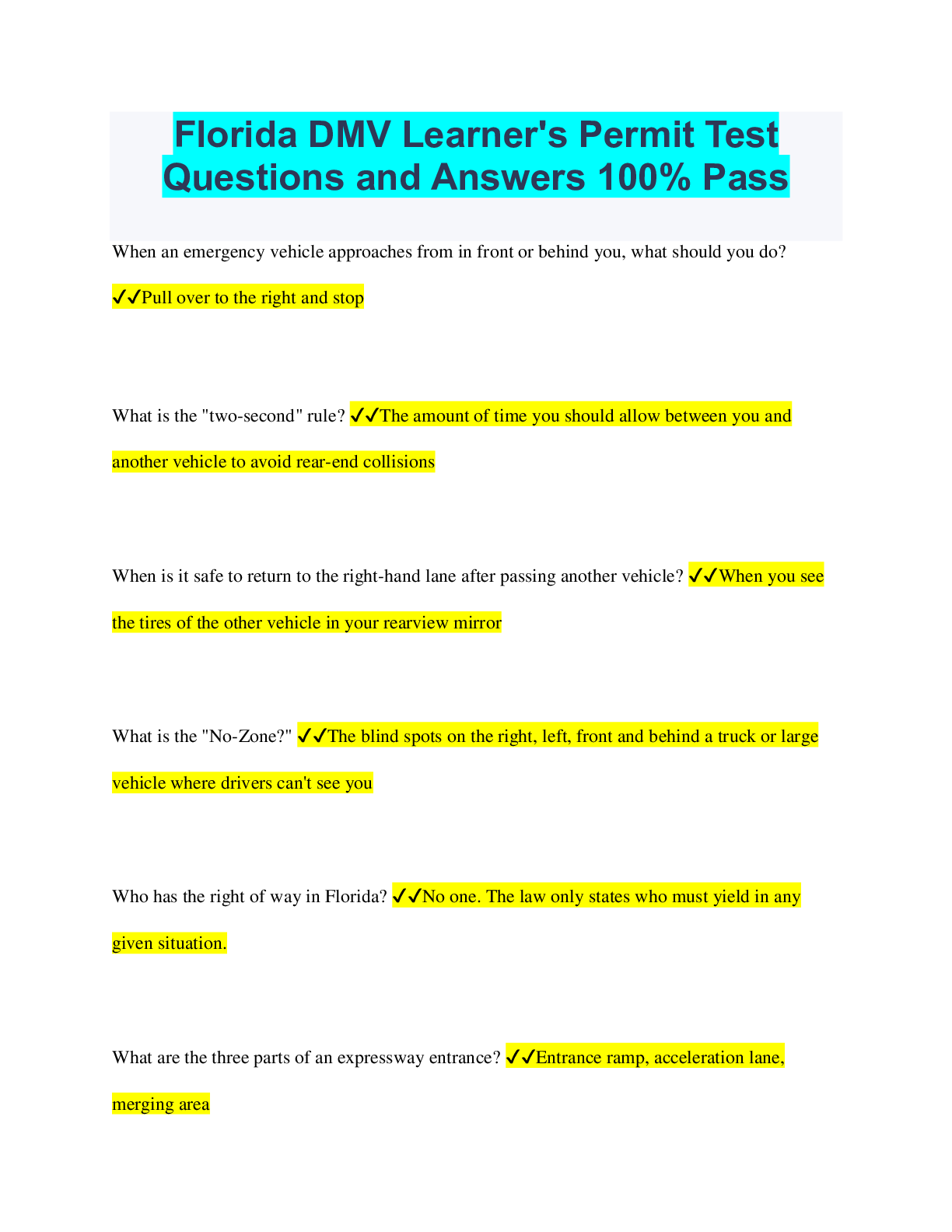
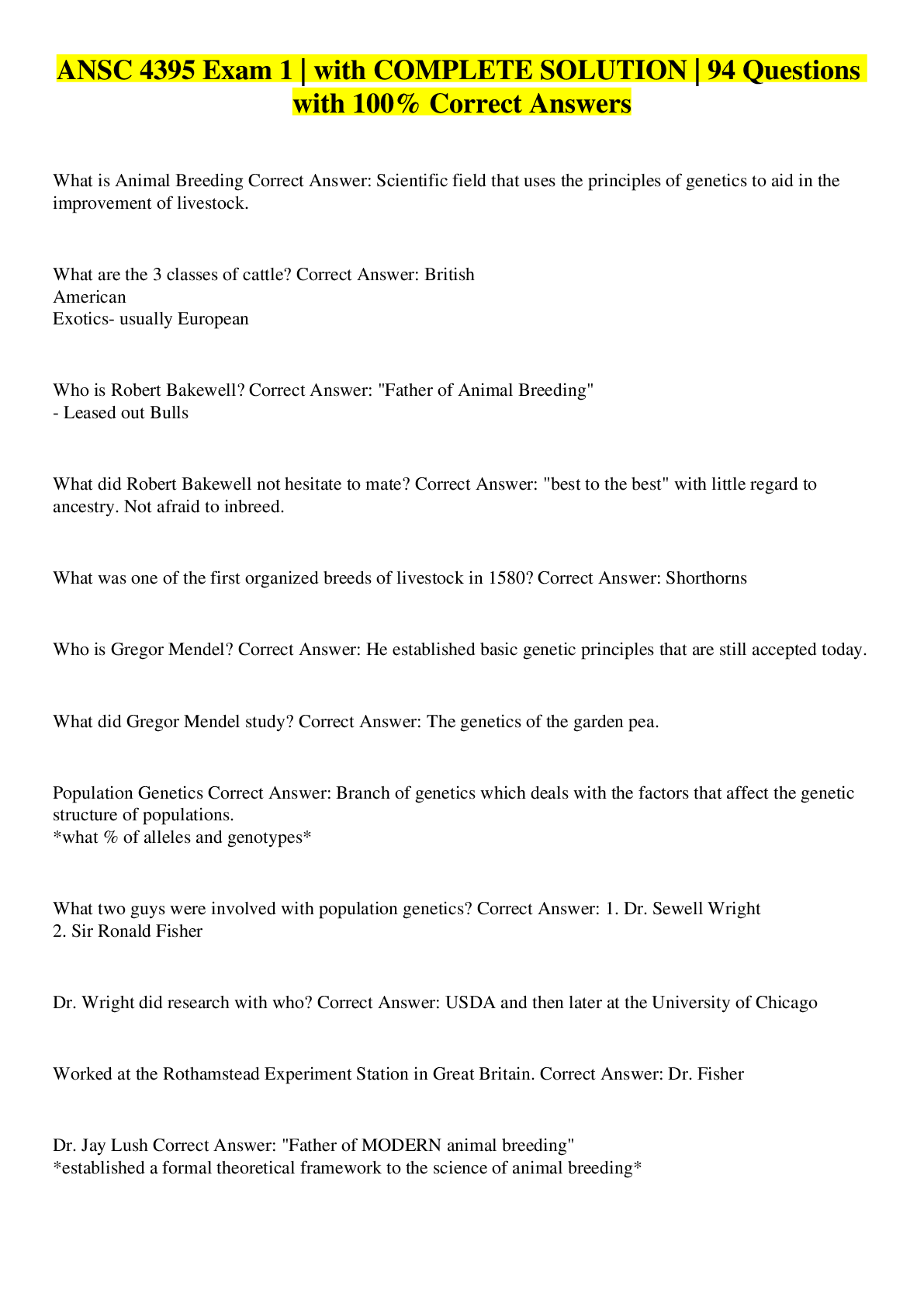

.png)







